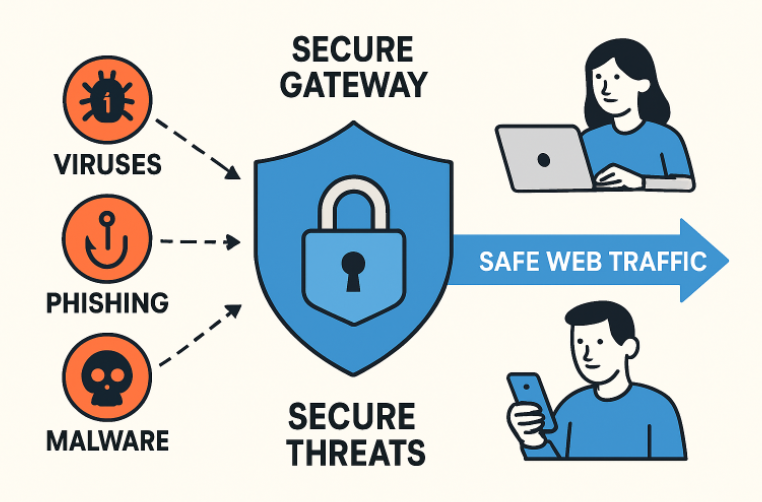The Role of Smart Web Gateways in Cybersecurity
Organizations and individuals encounter countless digital threats daily as they access content and connect across the internet. Protecting sensitive data and user privacy is no longer optional—it’s a necessity. This is where secure web gateway solutions come into play, providing a powerful shield that filters, monitors, and blocks potentially harmful web traffic. By acting as sentinels at the network’s entry point, Smart Web Gateways (SWGs) defend users from malware, phishing, and emerging cyberattacks that originate online.
SWGs combine multiple security tools, such as URL filtering, threat intelligence, and real-time content inspection, creating an agile and adaptive approach to web security. Deploying an SWG ensures that only safe, approved interactions and content reach end users, decreasing the risk of infections, breaches, and regulatory violations.
Evolution and Current Landscape of SWGs
Over the past decade, the role of SWGs has dramatically expanded. What began as simple mechanisms to block access to inappropriate websites now represents a comprehensive, cloud-enabled solution focused on defending against advanced digital threats. Today’s SWGs integrate artificial intelligence, behavioral analytics, and machine learning to detect suspicious activity long before it does damage proactively. According to projections from industry analysts, the global Smart Web Gateway market is expected to exceed $15 billion by 2025, propelled by relentless cybercrime and widespread cloud adoption.
This surge in demand also reflects the SWG’s ability to serve as a core pillar for converged cybersecurity, where network, web, cloud, and endpoint security conjoin to protect large, decentralized environments. Modern enterprises, schools, and government agencies rely on SWGs to ensure compliance with legal frameworks and real-time enforcement of organizational policies.
Recent Advancements in SWG Technology
Recent milestones underscore a fast-evolving SWG landscape. An example is Broadcom’s Symantec Cloud Secure Web Gateway earning FedRAMP authorization, which enables U.S. federal agencies to adopt advanced web security as they migrate to cloud infrastructure. Regulatory approval signals technical innovation and stringent commitment to robust, government-grade protection. FedRAMP-approved solutions like these set a benchmark, signaling industry-wide progress and raising the bar for commercial and public sector cybersecurity efforts.
Simultaneously, vendors across the sector are racing to integrate SWG platforms with cutting-edge threat intelligence feeds, zero-day exploit detection, and sandboxing for suspicious links and downloads. Adopting Secure Access Service Edge (SASE) models—combining SWG, firewall, CASB, and ZTNA—illustrates how security at the network perimeter converges around holistic defense-in-depth principles.
Challenges Facing SWGs
Despite these positive developments, Smart Web Gateways are not without their limitations. In a striking case presented at DEF CON 32, a team from SquareX demonstrated more than 30 techniques to bypass SWG defenses, revealing deep-seated architectural vulnerabilities that questioned the reliability of even the most advanced solutions. These exposures remind the industry that attackers continuously develop new evasion strategies, and SWG technologies must evolve accordingly. Organizations deploying SWGs must focus on regular updates, real-time monitoring, and adaptive controls to ensure resilience against the fast-changing threat landscape.
Integrating SWGs with Broader Security Frameworks
Leading security ecosystems merge Smart Web Gateways with solutions like Cloud Access Security Brokers (CASB) and Zero Trust Network Access (ZTNA) to counter increasingly sophisticated attacks. Integrations like those pioneered by Forcepoint ONE enable organizations to apply consistent security controls across disparate environments, including SaaS apps and private cloud resources. This unified approach reduces complexity for IT teams while enhancing user protection, regardless of device or location. The result is a simplified, more powerful security posture that helps organizations keep pace with today’s distributed, hybrid workplace realities.
SWGs in Protecting Minors Online
Beyond enterprise environments, Smart Web Gateways are increasingly vital in creating a safer digital world for children and young people. These advanced systems extend cybersecurity principles to online content moderation, protecting minors from harmful or age-inappropriate material. Emerging technologies like EdgeAIGuard, powered by agentic large language models, analyze vast amounts of online data in real time at the network’s edge, identifying and blocking risky or exploitative content before it reaches end users. This proactive filtering capability supports parents, schools, and youth organizations in maintaining safer digital spaces. As children spend more time online for learning, social interaction, and entertainment, such intelligent safeguards strengthen global efforts toward responsible technology use and uphold the broader mission of digital trust, ethics, and child protection.
Future Outlook for SWGs
The future of Smart Web Gateways (SWGs) depends on their capacity to evolve alongside the accelerating pace of technology and the increasingly sophisticated tactics of cybercriminals, in an era where cloud applications, remote work, and mobile access dominate. SWGs must go beyond static protection to provide intelligent, adaptive defense mechanisms. Continuous innovation through research, enhanced global threat intelligence sharing, and deep integration with AI-driven analytics will enable these systems to detect, predict, and prevent emerging threats in real time. Modern SWGs must deliver unmatched agility, granular visibility, and policy control for organizations embracing digital transformation—ensuring consistent, airtight protection across every platform, device, and location. Their success lies in maintaining flexibility and foresight in an ever-changing cybersecurity landscape.
Conclusion
As global connectivity expands and cyber threats grow, smart web gateways (SWGs) have become essential defenders of secure digital access. These intelligent systems act as the first line of defense, inspecting real-time traffic to detect and block malicious content, phishing attempts, and data leaks before they cause harm. Modern SWGs go beyond traditional filtering—they integrate with broader security architectures, including Zero Trust and cloud-native platforms, to deliver unified protection across networks and devices. Their adaptability makes them vital not only for enterprises but also for safeguarding individuals and vulnerable online communities. By investing in SWGs, organizations strengthen resilience, promote responsible web usage, and take a critical step toward building a safer, more trustworthy digital environment for everyone.







